外研版四年级英语下Module8 Unit1课件
- 格式:pptx
- 大小:83.85 MB
- 文档页数:49
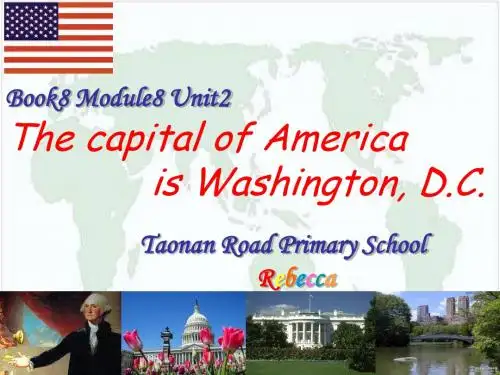
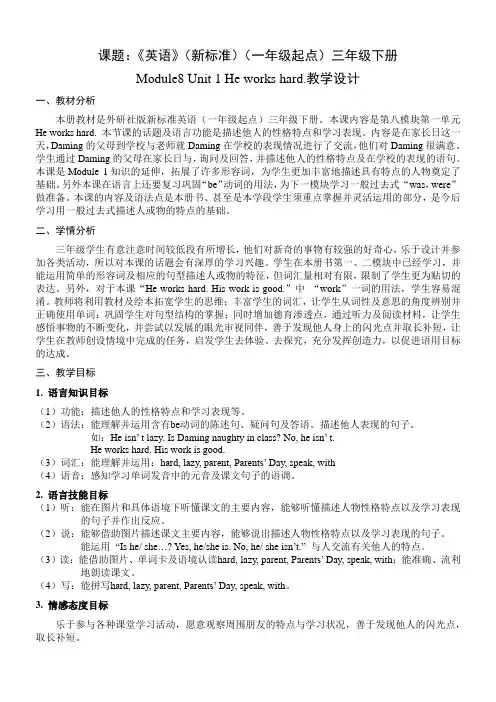
课题:《英语》(新标准)(一年级起点)三年级下册Module8 Unit 1 He works hard.教学设计一、教材分析本册教材是外研社版新标准英语(一年级起点)三年级下册。
本课内容是第八模块第一单元He works hard. 本节课的话题及语言功能是描述他人的性格特点和学习表现。
内容是在家长日这一天,Daming的父母到学校与老师就Daming在学校的表现情况进行了交流,他们对Daming很满意。
学生通过Daming的父母在家长日与,询问及回答,并描述他人的性格特点及在学校的表现的语句。
本课是Module 1知识的延伸,拓展了许多形容词,为学生更加丰富地描述具有特点的人物奠定了基础。
另外本课在语言上还要复习巩固“be”动词的用法,为下一模块学习一般过去式“was,were”做准备。
本课的内容及语法点是本册书、甚至是本学段学生须重点掌握并灵活运用的部分,是今后学习用一般过去式描述人或物的特点的基础。
二、学情分析三年级学生有意注意时间较低段有所增长,他们对新奇的事物有较强的好奇心,乐于设计并参加各类活动,所以对本课的话题会有深厚的学习兴趣。
学生在本册书第一、二模块中已经学习,并能运用简单的形容词及相应的句型描述人或物的特征,但词汇量相对有限,限制了学生更为贴切的表达。
另外,对于本课“He works hard. His work is good.”中“work”一词的用法,学生容易混淆。
教师将利用教材及绘本拓宽学生的思维;丰富学生的词汇,让学生从词性及意思的角度辨别并正确使用单词;巩固学生对句型结构的掌握;同时增加德育渗透点,通过听力及阅读材料,让学生感悟事物的不断变化,并尝试以发展的眼光审视同伴,善于发现他人身上的闪光点并取长补短,让学生在教师创设情境中完成的任务,启发学生去体验、去探究,充分发挥创造力,以促进语用目标的达成。
三、教学目标1. 语言知识目标(1)功能:描述他人的性格特点和学习表现等。
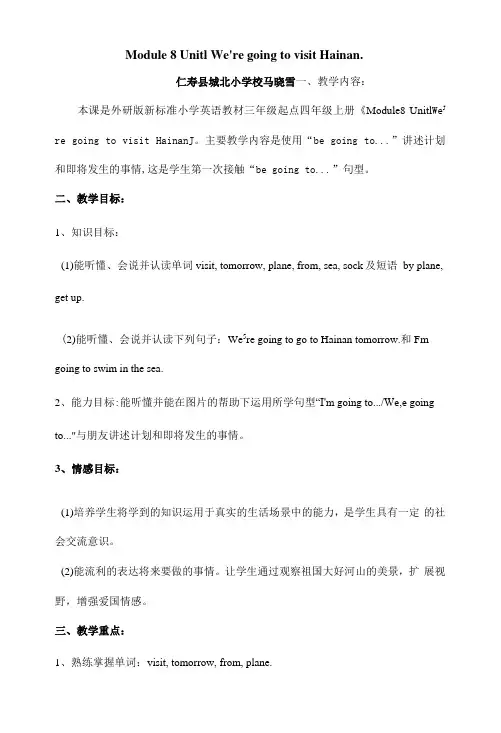
Module 8 Unitl We're going to visit Hainan.仁寿县城北小学校马晓雪一、教学内容:本课是外研版新标准小学英语教材三年级起点四年级上册《Module8 Unitl We J re going to visit HainanJ。
主要教学内容是使用“be going to...”讲述计划和即将发生的事情,这是学生第一次接触“be going to...”句型。
二、教学目标:1、知识目标:(1)能听懂、会说并认读单词visit, tomorrow, plane, from, sea, sock及短语by plane, get up.(2)能听懂、会说并认读下列句子:We5re going to go to Hainan tomorrow.和Fm going to swim in the sea.2、能力目标:能听懂并能在图片的帮助下运用所学句型“I'm going to.../We,e going to..."与朋友讲述计划和即将发生的事情。
3、情感目标:(1)培养学生将学到的知识运用于真实的生活场景中的能力,是学生具有一定的社会交流意识。
(2)能流利的表达将来要做的事情。
让学生通过观察祖国大好河山的美景,扩展视野,增强爱国情感。
三、教学重点:1、熟练掌握单词:visit, tomorrow, from, plane.2、能熟练运用句型“be going to...”来描述出行计划和即将做的事情。
四、教学难点:结合实际在真实的语境中运用"be going to..."o五、教学准备:教材、多媒体课件、单词卡片,旅游城市图片,游泳衣,旅行包。
六、教学过程:Stepl Warming upGreetings.1.Do and say.Swim, swim, I can swim.Skip, skip, I can skip.Run, run, I can run.Jump jump, I can jump.Step2 Presentation1.Make a duty report.T: What day is it today?55:Today is Thursday.(呈现台历)T: How about tomorrow? Tomorrow is Friday.(呈现单词卡片学习新单词tomorrow, to-mo-rrow.)2.①T: I'm going to visit the zoo tomorrow.(出示visit the zoo,呈现单词卡片学习单词visit.)Look at these boys, what are they talking,弓| 出"I'm going to go with you.”(操练句型"Fm going to...”)And I'm going to.(老师指着图片引导学生说出eat some fruit, drink some juice.)②Say a chant.A.播放活动1视频。
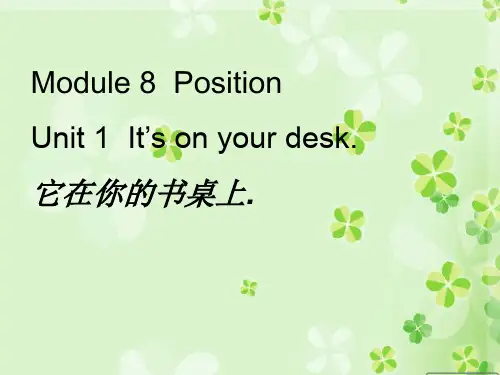
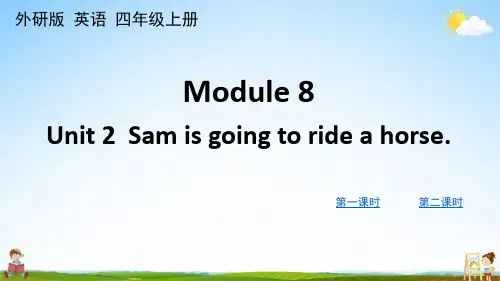
外研版 英语 四年级上册Module 8Unit 2 Sam is going to ride a horse.第一课时第二课时o’clock sock sea swimsuit tomorrowfromvisitplane get up第一课时幸运抽奖活动the moonthe UK Hainan老师出示四个地点。
准备一个纸盒,放着交通工具及要做的事情的图片。
学生抽取一个地方,然后从盒子里抽取一种交通工具和要做的事情,组成两个有趣的句子。
如:I’m going to visit Hainan by plane. I’m going to swim there.the zooswimfly a kiterow a boatride a horsetake some picturesShe is going to flya kite.He is going to row a boat. Listen, point and say.What is he going to do?He is going to fish.钓鱼(v)鱼 (n)Listen and fill. ____goingto fish.It’s__________too.____ going toeat the fish.Ha ha …It’sgoing to fishWe’reIt’s going to fish.It’s goingto fish too.We’re going toeat the fish.Ha ha …Listen and read after it.Game.一组学生在台前做相应动作表演,另一组学生在台后读对话,表演的那组学生要与对话的学生说出的语言口型一致。
We’re going to play in the park tomorrow.hooray(表示激动与高兴的喊声)好,好哇Listen and say.Hooray!Let’s say “hooray” together!Hooray!in the parkWhat are you going to do in the park?ride a horse row a boatfly a kitefishDo and chant.Fly, fly, fly a kite.Take, take, take some pictures.Ride, ride, ride a horse.Row, row, row a boat.Listen and fill.Name Amy Daming Sam Lingling Activity(活动)Listen and read after it.We’re going to playin the parktomorrow.Hooray!Amy is going to fly akite. Daming is goingto take some pictures.Sam is going to ride ahorse. Lingling is goingto row a boat. She’sgoing to fish too.Amy going to fly a kite.Sam going to ride a horse.It going to fish.I going to visit my grandpa.I going to swim.We going to visit Hainan.We going to get up at 5 o’clock. Let’s see.is is is am am are are be 动词随主语的变化而变化。
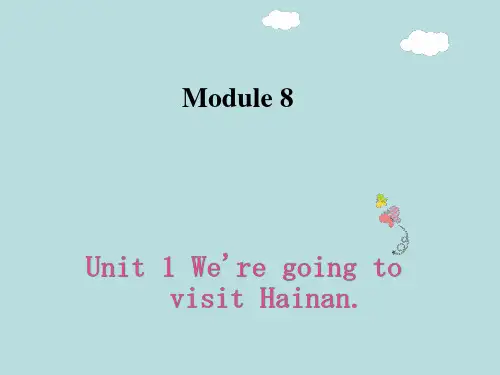
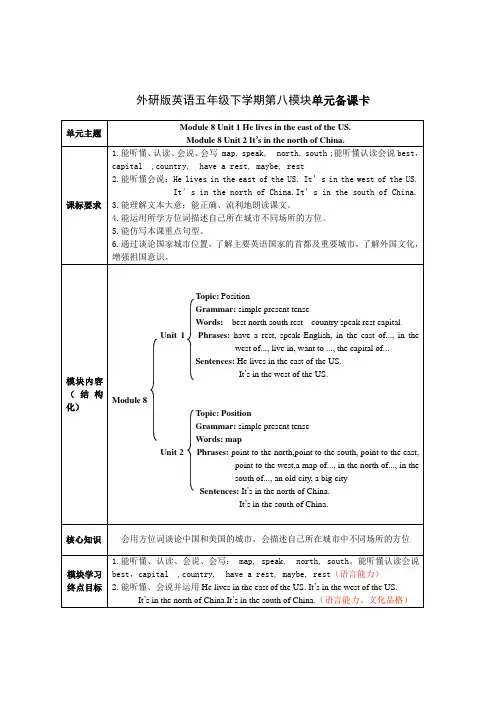
外研版英语五年级下学期第八模块单元备课卡单元达标测试题:四年级英语下册第八模块测试题一、选出划线字母发音不同的一项()1. A. time B. live C. like()2. A. put B. up C. study()3. A. best B. rest C. report()4. A. great B. each C. speak()5. A. have B. potato C. capital二、选出每组单词中不同类的一项()1. A dangerous B country C nervous()2. A map B speak C talk()3. A ran B sent C hear()4.A America B China C country()5 A north B west C in三、单项选择() 1. I want _____to Zhengzhou.A. goB. wentC. to goD. to going( ) 2. I will _______ to England.A. goB. wentC. goingD. goes( ) 3. -- ______ he live in Los Angeles? ---No, he doesn’t.A. DoesB. DoC. IsD. Can( ) 4. He can ______ to see me.A. comesB. cameC. comingD. come( ) 5. Guangzhou is _____ the south of China.A. inB. toC. outD. for( ) 6. ---Maybe you can visit your penfriend. ---_____A.Yes, I may be.B. Yes, maybe.C. No, maybe.D. Yes, I may. ( ) 7. Qingdao is _____ of China.A. in the eastB. to the eastC. in the westD. to west of ( ) 8. Does he ____ in Shanghai?A. liveB. livesC. livedD. living( ) 9. Maybe you can _____ your cousin.A. visitsB. visitC. visitedD. visiting( ) 10. ______ your cousin live in New York?A. DoB. DoesC. IsD. Did四、根据首字母提示完成句子1. My cousin l_______ there.2. Los Angeles is in the w______ of the US.3. New York is in the e_______ of the US.4. People live in China s______ Chinese .5. Mexico is to the s_______ of America.五、根据汉语意思在横线上填上词组1.People in the US .(讲英语)2.Los Angeles is (在…西部)the US.3.Maybe you can (拜访) your cousin.4.This is (一张…的图片)China.5.Suzhou is (在…东部)of China.六、选词填空in of our country go1.I want to __________to the US one day.2.This __________is China.3.I live __________ Weifang.4.Look at the map __________China.5.The hospital is in the east of __________city.七、连词成句1.English speak people in US the___________________________________________________________ 2.east in he the lives US the of___________________________________________________________ 3.Washington DC is capital the the US of___________________________________________________________ 4.west to point the_________________ __________________________________________5.north of the in it’s China___________________________________________________________八、按要求写句子1.Guangzhou is in the south of China. (对划线部分提问)________________________________________________2. Does he live in New York? (肯定回答)_________________________________________________3. Suzhou is an old city. (变成一般疑问句)___________________________________________________4. Does he live in the east of the US?(做否定回答)___________________________________________________5. She lives in Beijing.(变成否定句)___________________________________________________九、从B栏中找出A栏中问题的答语,将标号填在括号里A B( ) 1.Where is Qingdao? A. Yes,I can.( ) 2.Can you visit your grandpa? B. No, I don't.( ) 3.What's the capital of China? C. Beijing.( ) 4.Do you live in NewYork? D. It’s in the east of China.十、阅读理解(一)判断对错(T/F)Look at this map. It’s a map of China. Suzhou is in the east of China. It’s very old. Beijing is in the north of China. Beijing is the capital of China. It’s big .Lhasa is in the west of China. It’s beautiful. Guangzhou is in the south of China. It’s big,too. Lingling lives in Beijing. And every summer she goes to Guangzhou.( ) 1. Lingling lives in Guangzhou.( ) 2. It’ a map of China.( ) 3. Lhasa is in the east of China.( ) 4. Beijing and Guangzhou are big..( ) 5. Beijing is the capital of China.(二)阅读并回答问题。
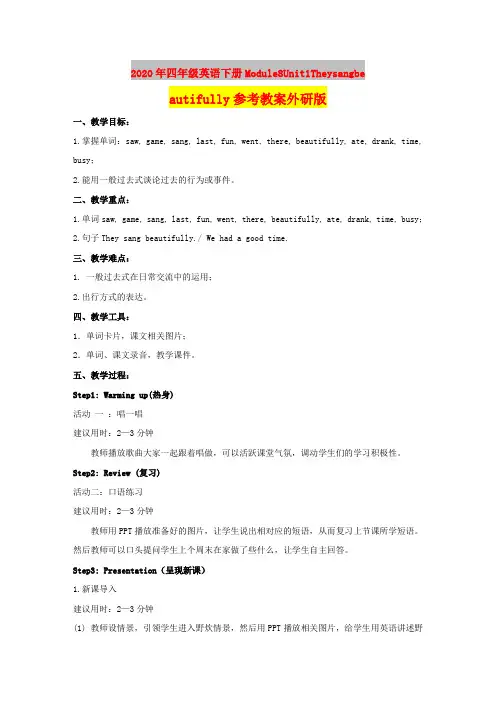
2020年四年级英语下册Module8Unit1Theysangbeautifully参考教案外研版一、教学目标:1.掌握单词:saw, game, sang, last, fun, went, there, beautifully, ate, drank, time, busy;2.能用一般过去式谈论过去的行为或事件。
二、教学重点:1.单词saw, game, sang, last, fun, went, there, beautifully, ate, drank, time, busy;2.句子They sang beautifully./ We had a good time.三、教学难点:1. 一般过去式在日常交流中的运用;2.出行方式的表达。
四、教学工具:1.单词卡片,课文相关图片;2.单词、课文录音,教学课件。
五、教学过程:Step1: Warming up(热身)活动一:唱一唱建议用时:2—3分钟教师播放歌曲大家一起跟着唱做,可以活跃课堂气氛,调动学生们的学习积极性。
Step2:Review (复习)活动二:口语练习建议用时:2—3分钟教师用PPT播放准备好的图片,让学生说出相对应的短语,从而复习上节课所学短语。
然后教师可以口头提问学生上个周末在家做了些什么,让学生自主回答。
Step3:Presentation(呈现新课)1.新课导入建议用时:2—3分钟(1) 教师设情景,引领学生进入野炊情景,然后用PPT播放相关图片,给学生用英语讲述野炊故事,并给学生简单讲解所涉及与本课相关的一些单词和短语。
之后让学生发挥想像,按自己的想象描述一下野炊期间的所见所闻。
2. 学习新单词建议用时:2—3分钟教师播放单词录音,让学生跟读单词。
并给学生讲述一般动词的一般过去时变位规则。
活动三:大小声游戏建议用时:5—6分钟教师出示单词卡片,让学生读出下面单词,每出示一个单词,老师小声读一遍,学生大声读三遍,然后反过来。
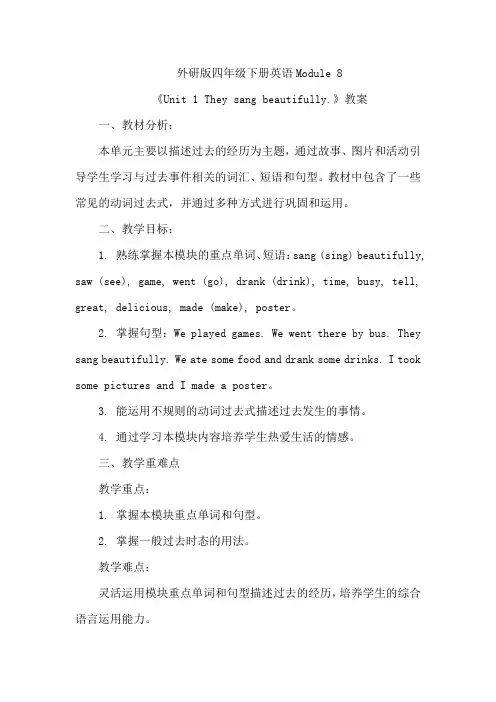
外研版四年级下册英语Module 8《Unit 1 They sang beautifully.》教案一、教材分析:本单元主要以描述过去的经历为主题,通过故事、图片和活动引导学生学习与过去事件相关的词汇、短语和句型。
教材中包含了一些常见的动词过去式,并通过多种方式进行巩固和运用。
二、教学目标:1. 熟练掌握本模块的重点单词、短语:sang (sing) beautifully, saw (see), game, went (go), drank (drink), time, busy, tell, great, delicious, made (make), poster。
2. 掌握句型:We played games. We went there by bus. They sang beautifully. We ate some food and drank some drinks. I took some pictures and I made a poster。
3. 能运用不规则的动词过去式描述过去发生的事情。
4. 通过学习本模块内容培养学生热爱生活的情感。
三、教学重难点教学重点:1. 掌握本模块重点单词和句型。
2. 掌握一般过去时态的用法。
教学难点:灵活运用模块重点单词和句型描述过去的经历,培养学生的综合语言运用能力。
四、学情分析:学生已经学习了基本的英语词汇和句型,对一般现在时态有一定的了解。
他们对动画、故事和图片等多媒体形式的教学资源感兴趣,喜欢通过多样化的活动来加深对知识的理解。
但在灵活运用过去时态和不规则动词过去式方面可能存在一定的困惑。
五、教学过程Step 1: Warmup (5 minutes)1. Greet the students and review the previous lesson briefly by asking questions related to the previous lesson's topic. For example, "Who can tell me one action word we learned last time?" Allow a few students to respond and provide positive reinforcement.2. Show pictures of different activities (e.g., singing, playing games, eating, etc.) and ask students to identify the actions in the pictures. Encourage them to use the present tense to describe the activities. For example, hold up a picture of children playing soccer and ask, "What are they doing in this picture?" Allow multiple students to respond and provide feedback on their answers.Step 2: Presentation (10 minutes)1. Introduce the new vocabulary words: sang, beautifully, saw, game, went, drank, time. Show flashcards or real objectsto illustrate the meanings of these words. For example, hold up a picture of someone singing and say, "Look at this picture. The person is singing. We can say they 'sang' beautifully." Repeat the process for the other vocabulary words.2. Play an audio or video clip of a song or a performance where people are singing. Ask students to listen and identify the action of singing. Then introduce the word "sang" and its meaning. For example, ask, "What did they do in the video? They sang!" Provide positive reinforcement for correct answers.3. Show a picture of a beautiful scene or performance and ask students to describe it using the word "beautifully." For example, show a picture of a ballet dancer and ask, "How did they perform? They danced beautifully! Can you use the word 'beautifully' in a sentence?" Encourage students to volunteer and provide feedback on their sentences.4. Present the past tense forms of the verbs: sang, saw, went, drank, made. Write these words on the board and explain that they describe actions that happened in the past. Give examples of sentences using these past tense verbs. For example, write on the board, "Yesterday, I sang a song. We went to the park last week." Read the sentences aloud, emphasizing the past tense verbs and their meanings.Step 3: Practice (15 minutes)1. Divide the class into small groups and give each groupa set of picture cards representing different activities (e.g., playing games, going somewhere, eating, taking pictures, making a poster).2. In their groups, students take turns picking a picture card and using the past tense to describe what they did in the past. Encourage them to use the target vocabulary and sentence structures. For example, a student picks a card with a picture of friends playing soccer and says, "I played games with my friends. We had a great time!" Encourage other group members to ask followup questions using the past tense. Provide assistance and feedback as needed.3. Circulate among the groups, listen to their conversations, and provide assistance as needed. Encourage students to use plete sentences and ask followup questions to extend their speaking. For example, if a student says, "I went to the park," ask, "Who did you go with? What did you do there?" Encourage other group members to contribute to the conversation.Step 4: Consolidation (10 minutes)1. Play a memory game with the past tense verbs. Write theverbs on the board and cover them. Remove one cover at a time, and students take turns trying to remember the past tense form and use it in a sentence. For example, reveal the word "drink" and a student says, "Drink, drank. I drank some juice yesterday." Provide positive reinforcement for correct answers and help students if they struggle.2. Have a class discussion about the students' favorite activities they did in the past. Encourage them to use the target vocabulary and sentence structures. For example, ask, "What games did you play? Where did you go? What did you eat?" Allow multiple students to share their experiences and ask followup questions to encourage further discussion. Provide positive feedback and praise their use of the target language.Step 5: Application (10 minutes)1. Assign a task for students to plete individually or in pairs. For example, ask them to write a short paragraph or draw a picture describing a past event using the target vocabulary and sentence structures. Provide sentence starters or prompts if necessary. For example, provide a sentence starter like "Last weekend, I..." or a prompt like "Draw a picture of something you did in the past."2. Circulate among the students, providing feedback andguidance as they work on the task. Encourage them to use a variety of past tense verbs and descriptive language. Provide positive reinforcement for their efforts and offer suggestions for improvement if needed.Step 6: Wrapup (5 minutes)1. Recap the key vocabulary, sentence structures, and grammar points covered in the lesson. Ask students to repeat the past tense verbs and their meanings. For example, say, "Let's review the past tense verbs we learned today. Repeat after me: sang, saw, went, drank, made." Encourage the students to say the words aloud and provide positive reinforcement.2. Ask a few students to share their paragraphs or pictures with the class. Provide positive feedback and praise their use of the target language. For example, say, "Who would like to share their paragraph or show their picture? That's wonderful!I love how you used the past tense verbs and described the event." Give specific pliments to highlight their achievements.3. End the lesson with a closing remark, such as, "Great job today, everyone! You did an excellent job learning and using the past tense. Keep practicing and using these new words and structures in your everyday conversations. See you next time!"六、板书设计:Unit 1: They sang beautifully.Vocabulary: sang(beautifully), saw (see), game, went (go), drank (drink), time, busy, tell, great, delicious, made (make), posterSentence Structures:We played games.We went there by bus.They sang beautifully.We ate some food and drank some drinks.I took some pictures and I made a poster.七、教学反思:本节课通过多样化的教学活动,引导学生学习和巩固了本模块的重点单词、短语和句型,并运用了一般过去时态描述过去的经历。
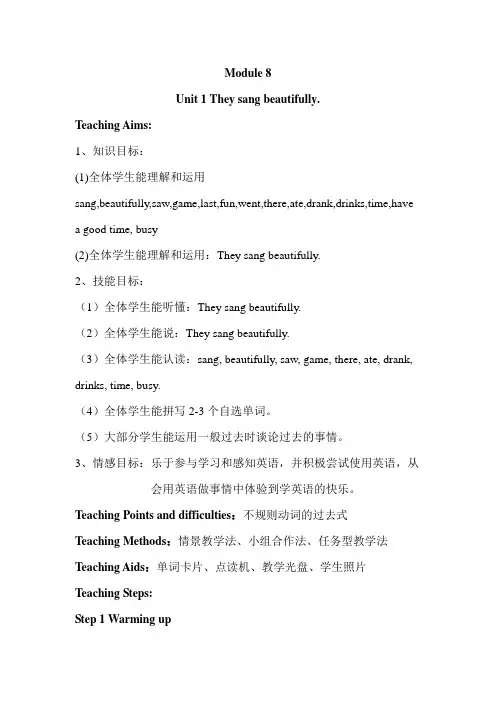
Module 8Unit 1 They sang beautifully.Teaching Aims:1、知识目标:(1)全体学生能理解和运用sang,beautifully,saw,game,last,fun,went,there,ate,drank,drinks,time,havea good time, busy(2)全体学生能理解和运用:They sang beautifully.2、技能目标:(1)全体学生能听懂:They sang beautifully.(2)全体学生能说:They sang beautifully.(3)全体学生能认读:sang, beautifully, saw, game, there, ate, drank, drinks, time, busy.(4)全体学生能拼写2-3个自选单词。
(5)大部分学生能运用一般过去时谈论过去的事情。
3、情感目标:乐于参与学习和感知英语,并积极尝试使用英语,从会用英语做事情中体验到学英语的快乐。
Teaching Points and difficulties:不规则动词的过去式Teaching Methods:情景教学法、小组合作法、任务型教学法Teaching Aids:单词卡片、点读机、教学光盘、学生照片Teaching Steps:Step 1 Warming up复习动词或词组,教师快速出示词组卡片go by bus,see some birds,sing,eat some food,drink some juice,have a picnic学生快速反应,脱口而出,教师将卡片贴在黑板上。
Step 2 Lead in当出示完最后一个词组have a picnic时,T:Do you like picnic?S:Yes,I do.T:Last Sunday,Amy and Sam had a picnic. 出示卡片并教读“Last Sunday”(贴黑板)。
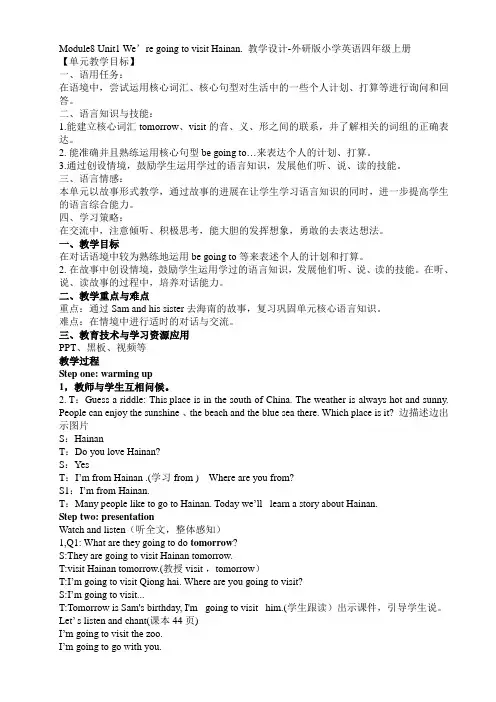
Module8 Unit1 We’re going to visit Hainan. 教学设计-外研版小学英语四年级上册【单元教学目标】一、语用任务:在语境中,尝试运用核心词汇、核心句型对生活中的一些个人计划、打算等进行询问和回答。
二、语言知识与技能:1.能建立核心词汇tomorrow、visit的音、义、形之间的联系,并了解相关的词组的正确表达。
2. 能准确并且熟练运用核心句型be going to…来表达个人的计划、打算。
3.通过创设情境,鼓励学生运用学过的语言知识,发展他们听、说、读的技能。
三、语言情感:本单元以故事形式教学,通过故事的进展在让学生学习语言知识的同时,进一步提高学生的语言综合能力。
四、学习策略:在交流中,注意倾听、积极思考,能大胆的发挥想象,勇敢的去表达想法。
一、教学目标在对话语境中较为熟练地运用be going to等来表述个人的计划和打算。
2. 在故事中创设情境,鼓励学生运用学过的语言知识,发展他们听、说、读的技能。
在听、说、读故事的过程中,培养对话能力。
二、教学重点与难点重点:通过Sam and his sister去海南的故事,复习巩固单元核心语言知识。
难点:在情境中进行适时的对话与交流。
三、教育技术与学习资源应用PPT、黑板、视频等教学过程Step one: warming up1,教师与学生互相问候。
2. T:Guess a riddle: This place is in the south of China. The weather is always hot and sunny. People can enjoy the sunshine 、the beach and the blue sea there. Which place is it? 边描述边出示图片S:HainanT:Do you love Hainan?S:YesT:I’m from Hainan .(学习 from ) Where are you from?S1:I’m from Hainan.T:Many people like to go to Hainan. Today we’ll learn a story about Hainan.Step two: presentationWatch and listen(听全文,整体感知)1,Q1: What are they going to do tomorrow?S:They are going to visit Hainan tomorrow.T:visit Hainan tomorrow.(教授visit ,tomorrow)T:I’m going to visit Qiong hai. Where are you going to visit?S:I’m going to visit...T:Tomorrow is Sam's birthday, I'm going to visit him.(学生跟读)出示课件,引导学生说。
Module8 Unit1 I was two.【教材分析及教法设计】本节课所学内容是外研版小学英语三年级起点第四册Module8 Unit1 I was two.本课主要是练习和运用句型I was two. They were young.这类语句向他人介绍过去的事情和状况。
这节课是学生第一次接触到一般过去式的结构,因此在课堂上只是告诉同学们在描述过去的状况时我们就使用这种结构。
在本课的教学中我采用了任务教学法和情景教学法组织教学,同时辅助电教手段调动学生视听感官、教唱英语歌曲等多种教学法灵活地融入教学中,激发学生学习兴趣,分散教学重难点,加深学生对语言的理解,帮助学生在语言与表达对象之间建立起联系,使学生能够在相对真实的情景中通过直观的感受,体验知识的生成与运用,从而更自觉、更有趣地进行英语交际活动,达到知识的内化。
同时教给学生如何通过细心观察、积极参与、合作交流等方法学会、掌握并运用知识的方法。
【学情分析】四年级的学生已经在三年级学习的基础上积累了一定的英语知识,包括一定的听说能力,学习的步骤及过程词汇的积累,和一些简单的语法等知识,在本单元学习中,学生的学习难度不会太大,重在培养学生的口语灵活运用能力和句型本意的准确表达。
另外,结合本课的学习,因为是有关过去的内容,四年级的学生从小到他们的现在,已经发生了不少变化,对其也有所了解,因此,学习本单元内容变得更加简单而有趣。
【教学目标】1.知识目标(1)基本能听懂、会说、会读、会写新单词who、grandparents、me、then、hair、was、were、so. (2)基本能听懂、会读、会说句型I was…. They were….(3)巩固复习词汇tall、short、fat、thin、old、young、cute、naughty、cool及句型I'm….Who is that little girl? It's….2.能力目标:(1)100%的学生可以听懂和感知课文内容,并且可以按照课文表述用was、were描述过去的状态。
Module 8Unit 1We’re going to go to Hainan说课稿一、说教材本课为《英语》小学(供三年级起始用)第三册Module8 Unit 1 We’re going to go to Hainan.主要呈现本模块所要学习的语言内容(We’re going to go to Hainan.),通过谈论图片学习如何使用“be going to”讲述自己的计划和即将发生的事情。
二、说学生本课的教学对象是四年级学生。
他们对英语的学习已有一定的基础,因此,在新语言点的学习过程中,教师要尽可能多地创造较好的语言环境,给学生充足的语言“习得机会”,让学生大胆实践,积极参与,形成积极的情感态度和自主学习的能力。
三、说教学目标1、知识目标(1)能听懂、会说并认读下列单词:children、tomorrow、from、China、swim、sea及短语: by plane、get up(2)能听懂、会说并认读下列句子We’re going to go to Hainan tomorrow. I’m going to swim in the sea.2、过程和方法目标能听懂并能在图片的帮助下运用“be going to”句型讲述自己的计划和即将发生的事情。
3、情感目标(1)培养学生将学到的知识运用于真实的生活场景中的能力,使学生具有一定的社会交流意识,引导学生关注生活,热爱生活。
(2)激发学生热爱祖国大好山河的情感。
四、说教学重、难点重点:(1)单词children、tomorrow、from、China、swim、sea及短语by plane、get up的认读。
(2)运用“be going to”句型描述即将做的事情。
难点:结合实际在真实的语境中运用“be going to” 句型。
五、说教具多媒体课件、单词卡片等六、说教法本节课我是以提高学生的综合素质为目的,以学生发展为本,努力做到面向全体学生:1、充分利用多媒体资源,给学生以形象、直观的信息,使知识的呈现生动有趣,同时还利用多媒体进行多样化的操练,不断激发学生的创造性思维。